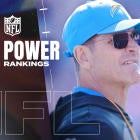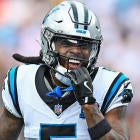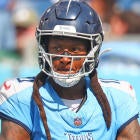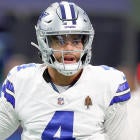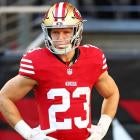The Green Bay Packers are headed to the NFC title game for the eighth time in franchise history. If they want to make it back to the Super Bowl for the first time since 2010, they'll have to get through the San Francisco 49ers. If they want to take home the trophy named after their famous coach, they'll need to defeat the Kansas City Chiefs or Tennessee Titans after that.
Both of those tasks, obviously, are easier said than done. In order to get there, they'll need a full team effort. Specifically, they'll need these five things to happen.
The Smiths (and Kenny Clark) keep dominating
Last week against Seattle, Za'Darius Smith and Preston Smith produced nearly identical stat lines: they each had two tackles, one of which went for a loss, plus two sacks and four quarterback hits. Za'Darius had 11 total pressures while Preston had seven, per Pro Football Focus, though part of that was due to the fact that Preston drops back in coverage far more often.
That game was a continuation of the strong season this duo had after general manager Brian Gutekunst handed them four-year deals totaling $118 million last offseason. Za'Darius led the NFL with 95 total pressures this season, and finished second in the league with 22 quarterback hits. Preston was a bit behind in pressures (55) and QB hits (10), but he only rushed the passer on 76 percent of opponent pass attempts, while Za'Darius did so 99 percent of the time.
The way they dominated Seattle's offensive line last week is what the Packers will need them to do against the 49ers, and then again against the Chiefs or Titans in the Super Bowl. They'll have some help up the middle from Kenny Clark, who had a pretty excellent season in his own right. Clark was one of the most underrated players in the NFL heading into this season, and all he did was have arguably the best year of his career.
Clark finished with six sacks and nine tackles for loss, and PFF credited him with 62 pressures -- 17th-most in the NFL and second among interior defenders, behind only Aaron Donald. They were also the only two players who primarily lined up inside that finished the year with 50-plus hurries. Clark, too, was excellent last week, notching a sack, a hit, and a tackle for loss among his four total tackles. Controlling the edges remains important in the modern NFL, but teams like the 49ers and Titans like to stretch the field horizontally in order to get the ball right up the middle a lot of the time, and Clark is one of the best up-the-middle defenders in the league.
The secondary steps up
Early in the season, the Packers' secondary, particularly cornerback Jaire Alexander, was excellent. Through the first four weeks of the season, Alexander ranked 15th in opponent's passer rating among 78 cornerbacks who played at least 100 passing snaps. Tramon Williams ranked 25th and Kevin King ranked 30th. Each of them was allowing a passer rating at least seven points below the league average.
In Weeks 5 through 12, the trio all backslid, and pretty badly. Alexander allowed a 114.1 passer rating during that time, 90th among 106 qualifying cornerbacks. King ranked 72nd among the same group with a 106.1 rating and Williams ranked 74th at 106.5. During the team's current six-game winning streak, which stretches back to Week 13, they have all rebounded. They rank ninth (King, 53.1), 23rd (Williams, 74.8), and 36th (Alexander, 88.4) among 93 qualified corners in opponent passer rating on throws in their direction.
The Seahawks decided last week that they'd be better off not testing the Green Bay secondary, leaning on the run until it was too late for Russell Wilson to work his magic. The 49ers are a run-heavy team as well, but they will take targeted shots and they will pick on a particular defender all game long if they think he's not up to snuff. The Titans are perfectly comfortable running until you prove you can stop them (and the Packers might have some trouble there), but the Chiefs will do the same thing with their passing attack. The Texans couldn't nearly keep up last week.
The Packers will need their secondary to play well to even make it to Miami, and if they get there, they'll have to either force Ryan Tannehill into one of his rare turnovers on the seldom occasion where he passes, or else keep up with Tyreek Hill, Travis Kelce, Sammy Watkins, Demarcus Robinson, and Mecole Hardman. All three of those tasks are sure to be pretty tough.
Lean on Aaron Jones as the feature back
When the Packers had the smack laid down upon them by the 49ers back in Week 12, Aaron Jones played only 52 percent of the offensive snaps, receiving just 13 carries for 38 yards. In every game since then, Jones has been on the field more and more often, and he has progressive received a larger share of the running back touches.
After nearly two full years of the Packers being reluctant to lean on Jones as their true feature back, it's been refreshing to see them do so over these past few weeks. His usage has peaked over the last three games, with Jones playing 68 percent, 85 percent, and 84 percent of the offensive snaps, and receiving 25, 27, and 22 total touches during those three games. By comparison, Jamaal Williams played only 27 percent of the snaps in Week 16, Tyler Irvin played only 19 percent in the Week 17 game Williams missed due to injury, and that duo combined for a 25 percent snap share in the divisional round.
Jones has averaged more yards per touch than Williams in each of their three NFL seasons, and he averages nearly a full yard more per touch over the course of their careers. He's a better runner: Jones averages more yards per carry and has a higher success rate at Football Outsiders. He's a better receiver: Jones averages more yards per reception and per target. Jones does a better job of breaking tackles: he has a much higher Elusive Rating at Pro Football Focus and broken tackle rate at Pro-Football-Reference. And Jones does a better job of creating splash plays: 5.5 percent of his carries this season gained 15 or more yards compared to 2.8 percent for Williams.
He should be Green Bay's feature back for however long they remain in the playoffs.
Get perimeter playmaking from someone other than Davante Adams
Davante Adams is coming off a monster game. He racked up eight catches for 160 yards and two scores, torching poor Tre Flowers just about every time they got matched up. Three of Adams' catches, totaling 74 yards and both of his scores, came against Flowers on the left side of the field.
If the Packers want to, they can move Adams around the formation once again on Sunday, the better to avoid Richard Sherman. The 49ers, like the Seahawks, play sides with their cornerbacks, which means Sherman will align on the offense's right side on a near every-snap basis. Across from him with be either Ahkello Witherspoon -- who was beaten for a deep touchdown by Stefon Diggs and then summarily benched -- for Emmanuel Moseley, who manned the position while Witherspoon was out with an injury during the regular season, and then again after Witherspoon was benched last week. They can also move Adams into the slot, where he can battle K'Waun Williams rather than Sherman.
The last time the Packers played against Sherman in the playoffs was in 2014, back when Adams was a rookie. Ahead of that game, we used the teams' Week 1 matchup as a lens into how Green Bay might approach the rematch:
All the way back in Week 1, the Seahawks beat the Packers 36-16 in Seattle in the NFL's season opener. Seattle's offense out-gained Green Bay by nearly 150 yards, controlling both the ball and the clock, while the defense held Aaron Rodgers and the Green Bay offense in check. There's a rematch Sunday with the NFC championship on the line, only these Seahawks aren't exactly those Seahawks, and these Packers aren't exactly those Packers.
...
The Packers in that Week 1 game sacrificed No. 3 receiver Jarrett Boykin at the altar of Richard Sherman, keeping him on Sherman's side of the field while trying to work Jordy Nelson and Randall Cobb elsewhere. Boykin has since lost his job to rookie Davante Adams, one of the stars of Green Bay's divisional-round win over the Dallas Cowboys. Dallas used Brandon Carr to shadow Nelson and Orlando Scandrick on Cobb, so Adams went to work on No. 3 corner Sterling Moore and came away with seven catches for 117 yards and a touchdown.
Green Bay did exactly what we predicted, lining Adams up across from Sherman for almost the entire game, while Nelson went to work on Byron Maxwell and Cobb battled Jeremy Lane in the slot. Green Bay moved Adams all over the field when these two teams played back in Week 12, but he didn't have much success. His seven catches on 12 targets gained only 43 total yards, and Rodgers was just 1 of 4 for seven yards when throwing to Adams against Witherspoon.
In other words, the Packers are going to need Allen Lazard or Geronimo Allison or Marquez Valdes-Scantling or Jake Kumerow or Jimmy Graham to make some plays. It can't be all Davante, all the time. The Niners will have answers for that.
Vintage Aaron Rodgers shows up
Green Bay may have gone 13-3, but the 2019 version of Rodgers was not nearly as good as what we've become used to over the years. Sure, Rodgers had a 26-to-4 touchdown-to-interception ratio, but he completed only 62 percent of his passes, the second-lowest mark of his career; he finished second in the NFL with 39 throwaways; he averaged only 7.0 yards per attempt, far below the league average; he threw touchdowns far less often than usual (4.6 percent of his throws compared to a career average of 6.0 percent); he posted his worst passer rating in four years and the third-worst mark of his career; and he set a new career-low in QBR.
Rodgers had a couple monster games where he just absolutely smoked the opposition: he was 46 of 64 for 672 yards, nine touchdowns, and zero interceptions in blowout wins over the Raiders and Giants. But he was largely ordinary otherwise, and flat-out bad in several games as well.
He was only 16 of 27 last week, but he made those completions count. He averaged 9.0 yards per attempt, threw for two scores, and went 8 of 10 for 124 yards and a score on third down, converting a third-and-7, two third-and-8s, a third-and-9, a third-and-10, and a third-and-12. That's the version of Rodgers the Packers are going to need in the NFC title game and the Super Bowl.










